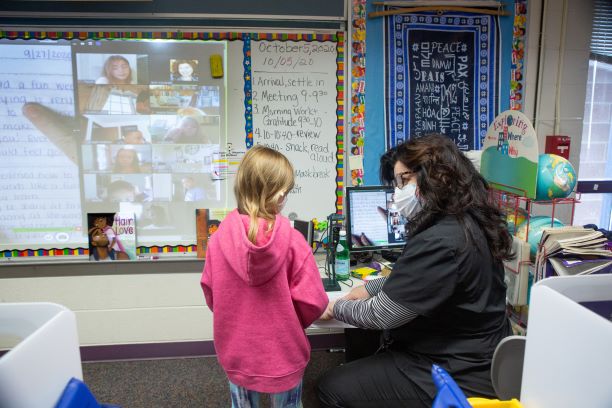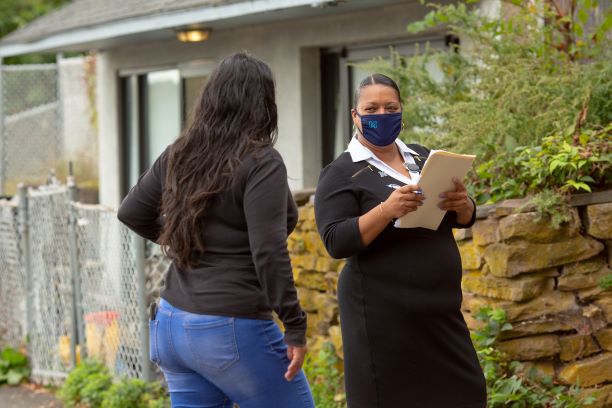Middletown Public Schools Reimagines and Personalizes Student Learning During COVID-19 Pandemic
As school districts nationwide struggle to educate their students during the COVID-19 pandemic, Middletown Public Schools in Connecticut has found its stride. This fall, the district successfully implemented a hybrid learning approach that provides its 4,600 students a mix of in-person and remote instruction. It hasn’t been easy, admits Superintendent Michael Conner, EdD. But through the hard work and dedication of Middletown’s innovative educators and school staff, the district has avoided the “cataclysmic learning loss” predicted nationally, he says. In fact, Middletown’s students are performing better in English language arts than they were one year ago and have experienced only minor learning loss in math, Conner says. Those results are significant in a district where half of the students come from historically underserved populations.
What is the secret to Middletown’s success?
“Practitioners with a growth mindset,” Conner says. “We can provide all the tools to our practitioners and to our leaders within the district, but having that level of agility, … their willingness to be creative and innovative in a compromised situation, … [and] their ability to pivot and make adaptions to their practice to improve has been commendable,” says Conner.
Colleen Weiner, principal at Middletown High School, agrees. “It’s a lot to manage for an educator to be teaching during a pandemic,” she says. “This isn’t like anything we are trained to do. … [But] I have tremendous teachers and staff who care so much for everyone, for each other, for the families and students. It’s the outpouring of people who are dedicated to their profession and trying everything they can possibly think of to keep kids engaged and motivated.”

Middletown, which joined the Alliance for Excellent Education’s (All4Ed’s) Future Ready Schools® (FRS) network in 2019, tested its hybrid learning approach during the summer before implementing it districtwide this fall. Under Middletown’s hybrid approach, which incorporates many strategies often used in blended learning instructional models, cohorts of students rotate to receive two days of in-person instruction and two days of synchronous remote instruction each week. To provide those four days of real-time instruction, teachers stream their classroom lessons and activities so they can teach their in-person and remote students concurrently. (Students also can receive all instruction remotely based on a personal preference or individual need. About 30 percent of Middletown’s students selected complete remote learning for this school year.) On the fifth day, Wednesday, all students pursue independent remote learning activities to allow teachers to participate in ongoing professional learning. (To learn more about Middletown’s complete FRS technology plan, watch this webinar.)
“We were one of the few districts that had in-person summer school,” says Tom Cannata, principal at Wesley Elementary School, which participated in the summer hybrid learning pilot. “That move provided a lot of input for us that made the transition to the fall much easier. … Our district had a clear vision for how hybrid learning would look and provided ongoing professional development. By providing [teachers with] that support, staff are in a better position to support students.”

The hybrid approach affords students greater flexibility and choice in their learning and pushes teachers to expand how they leverage technology to support instruction, say Cannata and Weiner. Meanwhile, using video conference platforms for teacher planning and professional development as well as for parent conferences facilitates efficient collaboration across the district and makes it easier for many families to connect with their children’s schools, they add.
“[The teachers] are starting to see the benefits of these new ways of teaching and some are getting excited about that and will use these [new] elements going forward,” Cannata says. “Even if we get back to full in-person school, many of these same technology programs will be used to allow students to collaborate differently.”

Yet implementing a hybrid instructional model during a pandemic still has challenges. Because the approach requires students to learn remotely three days per week, every student needs a personal device and reliable home internet access. Fortunately, Middletown’s middle and high school students already had district-issued laptops thanks to the district’s existing one-to-one initiative. Consequently, the district needed to provide devices only to its elementary students and establish a way to support families at home. The district created a dedicated phone line and e-mail address that families can contact to receive technology support and uses its meal distribution sites to collect broken devices and issue replacements. Meanwhile, through its community partnerships the district provided students in need with internet hot spots and free or low-cost home internet access.
Additionally, the physical separation between students and educators has made it more challenging to keep some students engaged in learning and to monitor students’ nonacademic needs, says Weiner. For instance, Weiner has noticed that fewer students access the school’s meal services since students do not come into the school building daily, even though extra meals are available for students to take home and pick up on their remote learning days. To keep students and families connected, the high school’s assistant principals and counselors conduct weekly home visits to students who selected complete remote learning and any hybrid students who do not participate regularly in their remote learning sessions, she adds.

“Some of the needs, unfortunately, we are not privy to,” Weiner says. “We’re constantly trying to keep students motivated to get onto their Zoom classroom links, be present in classrooms, and also balance the responsibilities they might have at home. Every situation for every child is unique, so there’s not a one-size-fits-all strategy or intervention that will work for each situation.”
Despite the challenges, Conner says the pandemic has created opportunities for Middletown and other districts to innovate and personalize learning to meet students’ individual needs.
“The pandemic has exacerbated inequities. That has been a persistent undertone,” he says. “[But] even though we saw some persistent inequities were exacerbated, it also gave us core knowledge on how to address these gaps using technology, using digital solutions, and using analytics to drive decision-making. … We should take these foundational learnings from the pandemic to continue to reimagine and redesign the current industrial model [of education] … that historically has left many students behind.”
Middletown is the latest school district featured in “American Education: Images of Teachers and Students in Action,” an online gallery of more than 700 original print-quality, royalty-free images of teachers and K–12 students. The collection includes 225 new photos captured this fall at Wesley Elementary School and Middletown High School that show what schooling looks like during the COVID-19 pandemic, spotlighting both in-person and remote learning for students and educators. The new images bookend a gallery of photos taken just before COVID-19 shut down schools in March, showing the before and after of American education during the pandemic.
The gallery, created with generous support from the William and Flora Hewlett Foundation, also includes images from Sutton Middle School, in Atlanta, Georgia; UCLA Community School in Los Angeles, California; Capital City Public Charter School in Washington, DC; MC2 STEM High School in Cleveland, Ohio; and Skyline High School in Oakland, California. To view and download photos from the collection, visit all4ed.org/images.
Kristen Loschert is editorial director at All4Ed.
Photos by Allison Shelley for American Education: Images of Teachers and Students in Action
